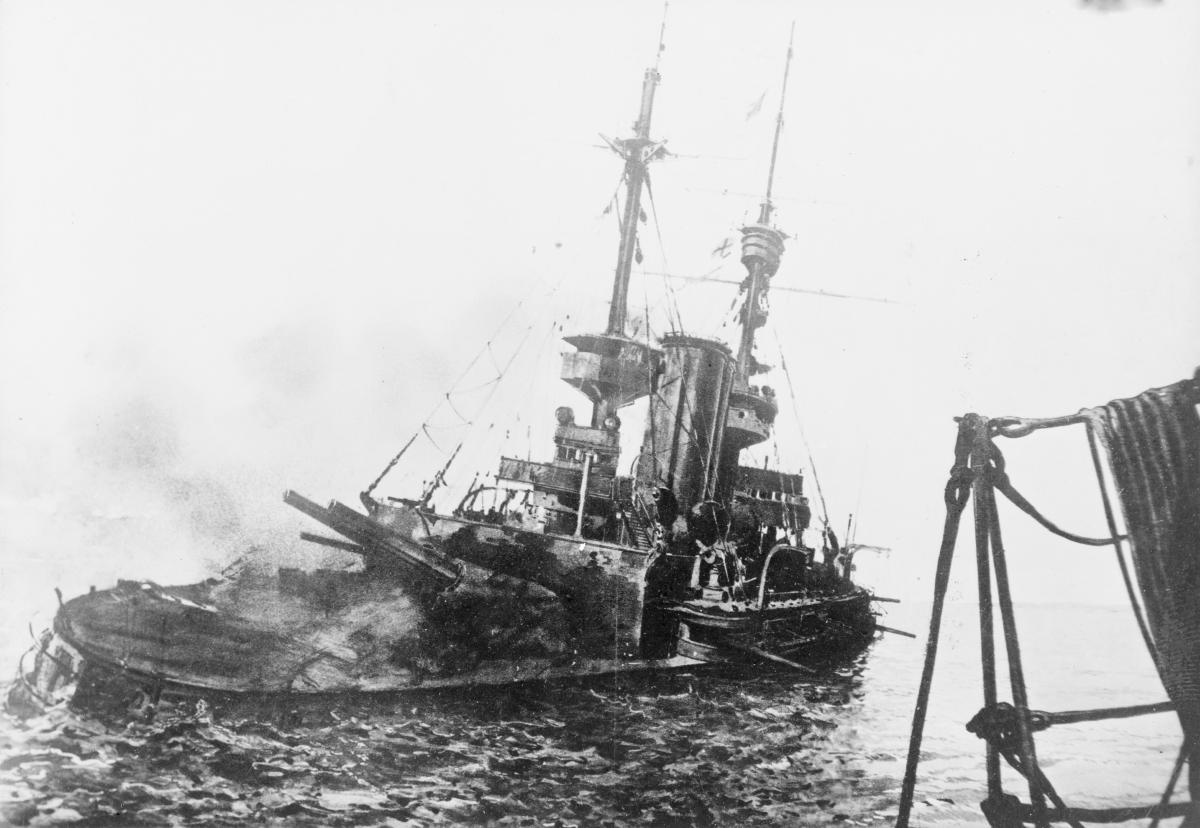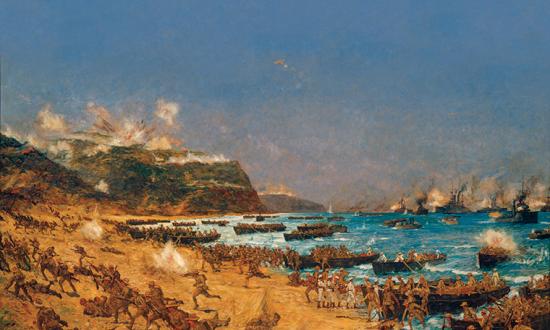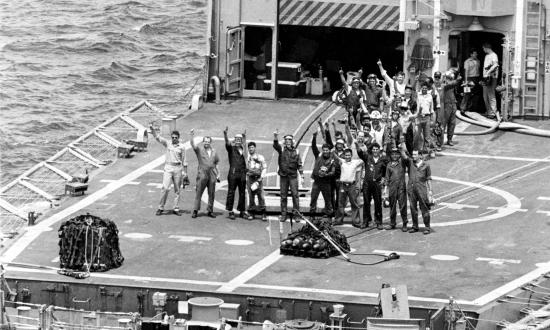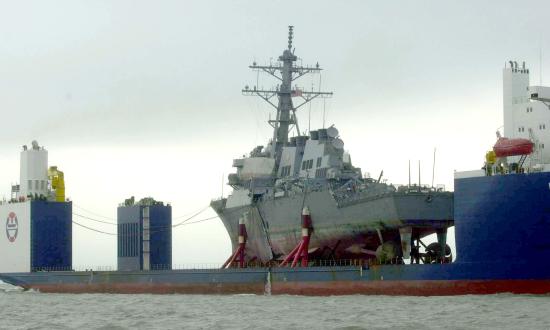Time and time again, mines have shown their lethality against modern and capable ships. There can be no doubt that naval mines can pose a serious threat. Modern, high-tech Western navies are ill-equipped to strike offensively with mines and have had mixed success in dousing their potency. The U.S. Navy and its allies must never underestimate the devastating offensive capabilities of naval mines or the eagerness of their adversaries to use them.
The Dardanelles
One morose example of how simple, inexpensive mines can guide the fate of nations is the failed Anglo-French attempt to force the Dardanelles Strait during World War I. Here, the Royal Navy—the world’s greatest naval power, which had comfortably ruled the waves since Trafalgar—faced off against the waning, flailing star of the Ottoman Empire.
Encouraged by how quickly and easily German artillery had laid waste to long-standing Western fortifications, the First Lord of the Admiralty, Sir Winston Churchill, corraled his department into the idea of forcing the Dardanelles with the Royal Navy. Here was Churchill’s opportunity to decisively flex the might of Britain’s sea power in a conflict that had been eclipsed by Europe’s land powers. There was scant glory for British arms in France, where the size of Britain’s force could not compete with others’ massive continental armies. Churchill’s justification was sound; the Royal Navy had at least 16 older battleships, ships unable to keep up with the Grand Fleet in the North Sea and unable to challenge German battleships, to be disposed of for scrap.1 Their loss would be inconsequential to the balance of naval power between the United Kingdom and Germany in the North Sea; their success, however, would rejuvenate and immeasurably change the conduct of the war.
The Western and Eastern fronts were stalling, with trifling morsels of progress dearly bought with horrific slaughter. The opening of the strait would allow Anglo-French weapons, munitions, and raw materials, necessary to support allied Russia’s industry, and would allow Russian wheat—a vital revenue stream that could have helped sustain the Russian war effort and perhaps prevented the collapse of the Tsarist government—to once again be sold on the international market.2
At the dawn of 1915, the Anglo-French armada to force open the Dardanelles Strait consisted of at least 15 battleships, one battlecruiser, six light cruisers, 24 destroyers, 52 minesweepers, an aircraft carrier, ten submarines, and supporting transports and auxiliaries.3 The minesweepers were converted fishing trawlers that still retained their prewar crews of fishermen.
The fleet was arrayed against scores of German and Ottoman fortifications and guns. The Narrows, 12 miles upstream from the strait’s entrance and the vital choke point of the strait, was less than a mile wide—and guarded by artillery on the cliffs and mines in the water.4
The opening phase of the operation seemed promising; the battleships handily defeated the outer coastal forts and scattered their defenders, and the fleet landed sailors and marines to demolish what had been left behind. As the ships inched forward into the narrowing confines of the strait, maneuverability and firing positions were constrained. The fleet, apprehensive of the mines, could only attempt to pinpoint where their attackers were firing from while anchored in place within the narrow channel. The Ottomans could fire from one location to another to sow confusion and blunt the accuracy of naval gunfire. The battleships were subjugated to a ferocious storm of gunfire while offering only modest response in turn. The minesweepers were sent in under the cover of the thundering cannon of the Allied warships in hopes of clearing a path forward, but they soon found themselves bombarded with Ottoman fire.
The fishermen knew their craft could be easily obliterated and waivered during their approach before ultimately withdrawing. The battleships, having expended hundreds of rounds and worn down their guns, had little to show for the effort. Most of the shells had passed harmlessly overhead of the Ottoman emplacements. The minesweepers attempted to force passage again under the cover of night, but Ottoman searchlights illuminated the hapless fishermen before unleashing a barrage of gunfire at them.5
The Ottomans, with their guns malfunctioning, their communications fraying, and their munitions depleting, were rushing to evacuate Istanbul of its treasures and key government functions. Most believed that it was only a matter of time before the Anglo-French fleet would break through the confines of the Narrows and reopen opportunity for Russia and the Balkan states.6 While the fleet was bombarding the coastal fortifications, the British and French squadrons swapped places in their lines of fire. During this exchange, a French battleship struck a mine before rapidly sinking beneath the waves. Her sudden loss was incredulous, but the fleet pressed on. Two British battlecruisers suffered the same fate. With three capital ships lost and three more unable to continue action, the fleet withdrew.7
The loss of three capital ships severely affected the psyche and morale of the fleet. Its commanders were severely reluctant to make another pass at the Narrows without knowing exactly how their prized ships were destroyed. Army observers on the ships concluded that the strait could not be forced by naval power alone and required ground support to make advances.8 With that in mind, the fleet’s commanders unanimously voted to wait for ground operations to commence and made no further attacks.9
Without knowing it, the Ottomans had permanently repulsed the fleet. The Great War would last another three years and the Russian Empire would collapse, re-emerging as the tyrannical Soviet Union. Henry Morgenthau, the U.S. ambassador the Ottoman Empire at the time, observed, “The whole Ottoman state, on that eighteenth day of March when the Allied fleet abandoned the attack, was on the brink of dissolution . . . but the great Allied armada never returned.”10
The Iran-Iraq War and Gulf War
The mine problem does not exist solely in older conflicts. A prominent strategic choke point that eclipses the importance of the Dardanelles is the Strait of Hormuz. During the Iran-Iraq War in the 1980s, both nations were known to lay dozens of mines to interfere with economic shipping in the Gulf region. Western nations underestimated the significance mines would play in this conflict and began their convoy-escort operations unprepared for this devastating weapon. More than a dozen ships struck mines in that contested region of the world, despite the intervention and minesweeping efforts of Western navies.11
In 1988, the USS Samuel B. Roberts (FFG-58) struck a mine while participating in Operation Earnest Will, the largest convoy-escort operation since World War II.12 So vital was the economic lifeline to the global markets, so precarious was the situation in the Gulf to the rest of the world, that both the United States and the Soviet Union made overtures to Libya, which was supplying Soviet-made mines to Iran, to stop any further exchange of Libyan naval mines for Iranian chemical weapons.13 Unable to ignore the strategic importance of mines, Iran maintains its own domestic capability to produce mines. A Revolutionary Guard commander, Rear Admiral Ali Fadavi, boasted “Our naval mines had left such an impression upon the Americans during Sacred Defense that they still live in apparent fear of these mines.”14
The Samuel B. Roberts, of course, is not the only U.S. warship to encounter mines. During the 1991 Gulf War, the cruiser USS Princeton (CG-59) and the amphibious assault ship USS Tripoli (LPH-10) both struck mines in the Persian Gulf.15 The peril of naval mines precluded larger and more ambitious naval and amphibious operations. No attempt was made to perform any amphibious assault of Kuwait; theater commander General H. Norman Schwarzkopf chose to overrun the heavily defended line in southern Iraq.
The Gulf Today
In 1915, wheat was the major economic commodity that needed to pass through the Dardanelles; in 2020, it is oil through the Hormuz. In 2018, 20.7 million barrels of oil per day traversed through the strait, up from 17.2 million in 2017; global consumption per day was 99.9 million barrels per day, up from 93.9 million in 2014. Global maritime oil trade was 62.5 million barrels, up from 56.4 million barrels in 2014.16 At its narrowest, the Strait of Hormuz is 21 miles wide, but the width of the shipping lane is a mere two miles.17 In 2018, the total capacity of Saudi and United Arab Emirates pipelines that could be used to bypass the seas was 6.8 million barrels. Despite its investment in overland oil pipelines, Saudi Arabia continues to ship the most oil through the strait.18
In 2007, Iran began a naval reorganization that culminated in assigning different geographic areas of responsibility (AOR) to the Islamic Revolutionary Guard Corps Navy (IRGCN) and the regular forces of the Islamic Republic of Iran Navy (IRIN).19 The IRGCN’s responsibility covers the Persian Gulf and the strait of Hormuz; the IRGCN will be the primary adversary to be fought and defeated. More so than the IRGCN, the IRIN is a traditional, professional navy. The IRGCN practices asymmetric warfighting that emphasizes decentralization, high maneuverability, and surprise. The IRGCN has been known to harass and interdict shipping by boarding or firing on vessels.20 In just 2019, six tankers were attacked in the Gulf of Oman and an American drone was obliterated out of the sky by Iranian antiaircraft batteries.21
The concept of operations relies on concealment, deception, hit-and-run surprise attacks, and swarm tactics using a large quantity of unsophisticated lethal weapons to overwhelm technologically superior adversaries. The IRGCN is capable of equipping a large number of its Ashura-class speedboats to quickly lay small amounts of mines.22 The ability to rapidly swarm small craft to a location and mine a strategic waterway could prove to be the undoing of any U.S. effort to maintain the strait as an open sea lane. These are the inexpensive, numerous forces that the larger, more advanced combatants of the U.S. Navy must exchange blows with.
Preparing for War
Let there be lessons learned from the gallant but ill-fated Dardanelles expedition. First is that the mine, in the hands of a lesser naval power against a far more formidable force, can balance the scales of power in a region. It would be wrong to assume the IRGCN would not make liberal use of naval mines. As the strait and the Persian Gulf are Iran’s backyard, the IRGCN operates with a home-field advantage. Its ability to rapidly mass small boats in great concentration to strategic choke points cannot be underestimated. It took only a single small boat alongside the USS Cole (DDG-67) to place a destroyer out of service. With its history of asymmetrical warfare, it cannot be assumed that, in an armed conflict, the IRGCN would not resort to similar attacks or enlist the aid of terrorist organizations to conduct the attacks on its behalf. Indeed, no port in Central Command’s AOR should be considered impenetrable to such duplicitous forms of warfare.
Second, while many look for the next technological breakthrough to achieve victory, let us observe that the British and French capabilities outmatched Ottoman naval capability just as the USS Samuel B. Roberts outmatched any ship the Iranians had in their navy. The IRGCN looks to doctrine and strategy; the U.S. Navy must be no different in this regard to ensure the overwhelming superiority of resources and firepower is not squandered.
At the Dardanelles, the British and French were reluctant to part with any divisions from Europe to attack the Ottomans. Despite a year of slaughter with no result save stagnation, the armies of France and the United Kingdom insisted on a purely naval operation to seize the strait. Even had the Anglo-French fleet barged through the Narrows there could be no hope of maintaining it without adequate ground support. The Ottomans could re-mine the strait and trap the fleet and its dwindling supply of coal and ammunition. The early approaches, where the fleet rendered the coastal batteries inert and where the marines landed ashore and demolished the abandoned fortifications, were textbook joint operations. (The marines eventually were driven back to their ships by a numerically superior force.) It is clear that any modern effort to reverse Iranian overtures to close the Strait of Hormuz must be a joint operation.
It is also clear that at least one side of the strait must be held so that ground and aerial forces can support mine-clearance operations. Access must be obtained, either diplomatically for rights to the United Arab Emirates’ side of the narrowest point of the strait, or militarily by seizing Iranian territory. In 1915 and today, a base of operations near the engagement zone is vital. Bases would allow surveillance planes and drones to provide consistent coverage of the Gulf without risking an aircraft carrier. A naval passage absent of ground and aerial support through the strait should not be attempted, particularly because of the IRGCN’s propensity to swarm larger vessels.
The navies of today have far fewer ships than the navies of 1915 did, and none of our high-end combatants are expendable. The U.S. Navy, with its long-range precision weapons, should not advance past the Gulf of Oman and present itself as a target for asymmetric hit-and-run attacks. The Navy’s role should be to launch the opening salvo of long-range cruise missiles to overwhelm as many of the known Iranian defenses as possible before rapidly landing an assault force on Iranian shores. From there, the Navy should relegate itself to a support role for the land and air forces. To commit and lose destroyers and cruisers to the quagmire of naval attrition is foolhardy when high-end combatants must be reserved to fight against our traditional and upcoming naval adversaries.
1. Admiral Sir Reginald H. Bacon, The Life of Lord Fisher of Kilverstone, (Garden City, NJ: Doubleday, Doran & Company, 1929), 222.
2. Robert K. Massie, Castles of Steel: Britain, Germany and the Winning of the Great War at Sea, (New York: Random House, 2003), Chapter 26.
3. Bacon, Life of Lord Fisher, 222.
4. Massie, Castles of Steel, Chapter 24.
5. Massie, Castles of Steel, Chapter 24.
6. Massie, Castles of Steel, Chapter 25.
7. Bacon, Life of Lord Fisher, 221.
8. Bacon, Life of Lord Fisher, 221.
9. Bacon, Life of Lord Fisher, 227.
10. Massie, Castles of Steel, Chapter 25.
11. John H. Cushman Jr., “U.S. Finds 2 Mines Where Ship Was Damaged,” The New York Times, 16 April 1988.
12. Cushman, “Blast Damages U.S. Frigate.”
13. Elaine Sciolino, “U.S. and Soviet Protest to Libya Over Iran Mines,” The New York Times, 11 September 1987.
14. Iranian Naval Forces: A Tale of Two Navies, (Suitland, MD: Office of Naval Intelligence, 2017), 29.
15. R. W. Apple Jr., “2 U.S. Ships Badly Damaged by Iraqi Mines in Persian Gulf,” The New York Times, 19 February 1991.
16. Justine Barden, “The Strait of Hormuz is the world’s most important oil transit chokepoint,” U.S. Energy Information Administration, 20 June 2019.
17. Lejla Villar and Mason Hamilton, “World Oil Transit Chokepoints,” (Washington, DC: U.S. Energy Information Administration, 2017), 4–6.
18. Barden, “Strait of Hormuz is the world’s most important.”
19. Iranian Naval Forces, 5.
20. Iranian Naval Forces, 22.
21. Weiyi Cai, Denise Lu, and Anjali Shinghvi, “Three Attacks in the World’s Oil Choke Point,” The New York Times, 21 June 2019.
22. Iranian Naval Forces, 29.






